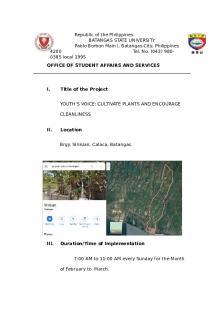Comp 851-proposal - project proposal PDF

| Title | Comp 851-proposal - project proposal |
|---|---|
| Author | MRINMOY SARKAR |
| Course | Big Data Analytics |
| Institution | North Carolina A&T State University |
| Pages | 2 |
| File Size | 150.1 KB |
| File Type | |
| Total Downloads | 89 |
| Total Views | 191 |
Summary
project proposal...
Description
Mrinmoy Sarkar Banner Id.: 950363260
PROJECT PROPOSAL Date: 8/20/2018
Comp 851: Big Data Analytics & Data Science Semester: Fall 2018
a) Title: Segmentation of seismic image for detection of salt below the earth surface b) Introduction: Different areas of earth have a large accumulation of oil, gas and also huge deposit of salt below the earth surface. However, precisely detecting the exact location of salt deposits is very difficult. Therefore, professional seismic imaging still requires expert human interpretation of salt bodies. This leads to very subjective, highly variable renderings. More alarmingly, it leads to potentially dangerous situations for oil and gas company drillers. Hence, to create the most accurate seismic images and 3D renderings, we need a robust algorithm that automatically and accurately identifies if a surface target is salt or not. c) Description: A seismic image is produced from imaging the reflection coming from rock boundaries. The seismic image shows the boundaries between different rock types. In theory, the strength of reflection is directly proportional to the difference in the physical properties on either side of the interface. While seismic images show rock boundaries, they don't say much about the rock themselves; some rocks are easy to identify while some are difficult. There are several areas of the world where there are vast quantities of salt in the subsurface. One of the challenges of seismic imaging is to identify the part of subsurface which is salt. Therefore, a set of images have been chosen at various locations and chosen at random in the subsurface. The images are 101 x 101 pixels and each pixel is classified as either salt or sediment. In addition to the seismic images, the depth of the imaged location has been recorded for each image. In this project data driven techniques, especially deep learning techniques (CNN, R-CNN, FAST-RCNN etc.) or Bayesian Network, will be used to develop a model which will be trained with those images and then the model will be validated. d) Programming language/tools: In this project Python will be used as the programming language along with TensorFlow to develop Deep learning models or pgmpy for Bayesian network. Python is used for this project because it has a huge set of libraries and tool box and most of the machine learning experts are using it for their projects. The python community is huge and active. TensorFlow is used for deep learning framework because it has efficient GPU implementation of tensors. So, with simple or no change same code can be run on CPU and GPU. Along with these tools pandas, NumPy, matplotlib or scikit-learn may be used.
Mrinmoy Sarkar Banner Id.: 950363260
PROJECT PROPOSAL Date: 8/20/2018
Comp 851: Big Data Analytics & Data Science Semester: Fall 2018
e) Block diagram of the system:
Training Seismic Image Test Seismic Image
Initial Model or Neural Network Architecture
Final Model
Final Model
Segmented Image with annotation of salt and sediment
f) Possible outcomes: a. A new system will be developed, which will use state-of-the-art machine learning technique to segment seismic image into salt or sediment b. The system will substitute human expert and automate the process of analysis of seismic image c. The system will reduce the cost of identifying an earth surface before mining d. Based on the result and novelty, the project can be published as a journal or conference paper g) Gantt Chart: Literature Review Learning of Python Tools Data Visualization Coding of simple model Development of main codebase Fine Tuning Of the model Documentation of the result Preparing the final paper
N.B.: W stands for Week
W
W
W
W
W
W
W
W
W
W
1
2
3
4
5
6
7
8
9
10...
Similar Free PDFs

COMP-533 project
- 3 Pages

Project Proposal
- 3 Pages

project proposal
- 7 Pages

Project Proposal
- 1 Pages

Project Proposal
- 16 Pages

PROPOSAL PROJECT
- 1 Pages

NSTP - Project Proposal Sample
- 3 Pages

Final Project Proposal
- 11 Pages

Project Proposal CS128
- 7 Pages

C- Programming Project proposal
- 1 Pages

CSC186 Proposal Project
- 5 Pages

NSTP- Project Proposal
- 14 Pages

Final YEAR Project Proposal
- 12 Pages

NSTP Project Proposal Edited
- 13 Pages
Popular Institutions
- Tinajero National High School - Annex
- Politeknik Caltex Riau
- Yokohama City University
- SGT University
- University of Al-Qadisiyah
- Divine Word College of Vigan
- Techniek College Rotterdam
- Universidade de Santiago
- Universiti Teknologi MARA Cawangan Johor Kampus Pasir Gudang
- Poltekkes Kemenkes Yogyakarta
- Baguio City National High School
- Colegio san marcos
- preparatoria uno
- Centro de Bachillerato Tecnológico Industrial y de Servicios No. 107
- Dalian Maritime University
- Quang Trung Secondary School
- Colegio Tecnológico en Informática
- Corporación Regional de Educación Superior
- Grupo CEDVA
- Dar Al Uloom University
- Centro de Estudios Preuniversitarios de la Universidad Nacional de Ingeniería
- 上智大学
- Aakash International School, Nuna Majara
- San Felipe Neri Catholic School
- Kang Chiao International School - New Taipei City
- Misamis Occidental National High School
- Institución Educativa Escuela Normal Juan Ladrilleros
- Kolehiyo ng Pantukan
- Batanes State College
- Instituto Continental
- Sekolah Menengah Kejuruan Kesehatan Kaltara (Tarakan)
- Colegio de La Inmaculada Concepcion - Cebu

